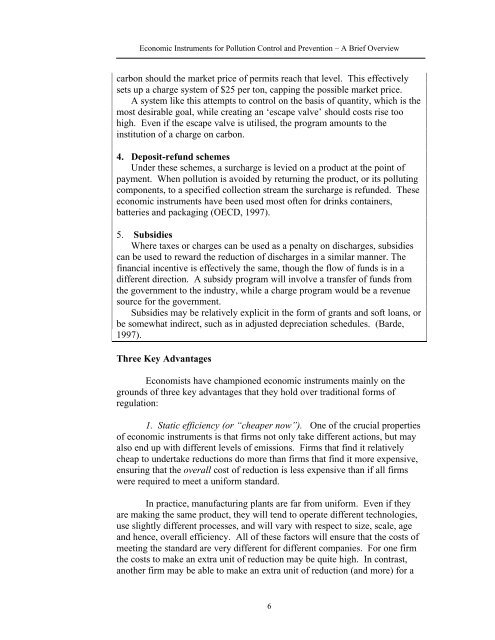Economic Instruments for Pollution Control and Prevention - World ...
Economic Instruments for Pollution Control and Prevention - World ...
Economic Instruments for Pollution Control and Prevention - World ...
You also want an ePaper? Increase the reach of your titles
YUMPU automatically turns print PDFs into web optimized ePapers that Google loves.
<strong>Economic</strong> <strong>Instruments</strong> <strong>for</strong> <strong>Pollution</strong> <strong>Control</strong> <strong>and</strong> <strong>Prevention</strong> – A Brief Overview<br />
carbon should the market price of permits reach that level. This effectively<br />
sets up a charge system of $25 per ton, capping the possible market price.<br />
A system like this attempts to control on the basis of quantity, which is the<br />
most desirable goal, while creating an ‘escape valve’ should costs rise too<br />
high. Even if the escape valve is utilised, the program amounts to the<br />
institution of a charge on carbon.<br />
4. Deposit-refund schemes<br />
Under these schemes, a surcharge is levied on a product at the point of<br />
payment. When pollution is avoided by returning the product, or its polluting<br />
components, to a specified collection stream the surcharge is refunded. These<br />
economic instruments have been used most often <strong>for</strong> drinks containers,<br />
batteries <strong>and</strong> packaging (OECD, 1997).<br />
5. Subsidies<br />
Where taxes or charges can be used as a penalty on discharges, subsidies<br />
can be used to reward the reduction of discharges in a similar manner. The<br />
financial incentive is effectively the same, though the flow of funds is in a<br />
different direction. A subsidy program will involve a transfer of funds from<br />
the government to the industry, while a charge program would be a revenue<br />
source <strong>for</strong> the government.<br />
Subsidies may be relatively explicit in the <strong>for</strong>m of grants <strong>and</strong> soft loans, or<br />
be somewhat indirect, such as in adjusted depreciation schedules. (Barde,<br />
1997).<br />
Three Key Advantages<br />
Economists have championed economic instruments mainly on the<br />
grounds of three key advantages that they hold over traditional <strong>for</strong>ms of<br />
regulation:<br />
1. Static efficiency (or “cheaper now”). One of the crucial properties<br />
of economic instruments is that firms not only take different actions, but may<br />
also end up with different levels of emissions. Firms that find it relatively<br />
cheap to undertake reductions do more than firms that find it more expensive,<br />
ensuring that the overall cost of reduction is less expensive than if all firms<br />
were required to meet a uni<strong>for</strong>m st<strong>and</strong>ard.<br />
In practice, manufacturing plants are far from uni<strong>for</strong>m. Even if they<br />
are making the same product, they will tend to operate different technologies,<br />
use slightly different processes, <strong>and</strong> will vary with respect to size, scale, age<br />
<strong>and</strong> hence, overall efficiency. All of these factors will ensure that the costs of<br />
meeting the st<strong>and</strong>ard are very different <strong>for</strong> different companies. For one firm<br />
the costs to make an extra unit of reduction may be quite high. In contrast,<br />
another firm may be able to make an extra unit of reduction (<strong>and</strong> more) <strong>for</strong> a<br />
6

















